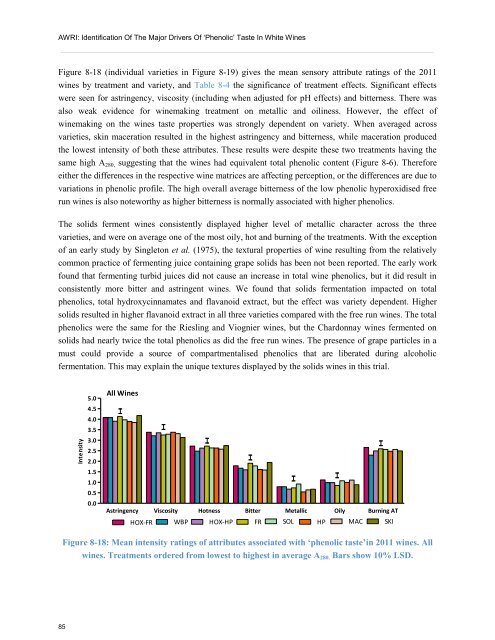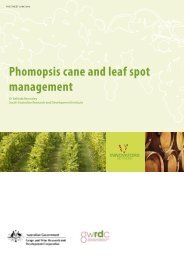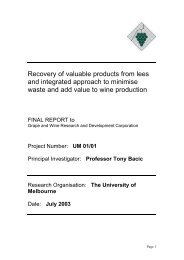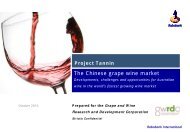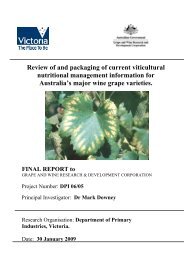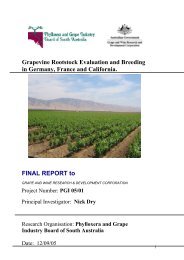Identification of the major drivers of 'phenolic' taste in ... - GWRDC
Identification of the major drivers of 'phenolic' taste in ... - GWRDC
Identification of the major drivers of 'phenolic' taste in ... - GWRDC
You also want an ePaper? Increase the reach of your titles
YUMPU automatically turns print PDFs into web optimized ePapers that Google loves.
AWRI: <strong>Identification</strong> Of The Major Drivers Of ‘Phenolic’ Taste In White W<strong>in</strong>es<br />
Figure 8-18 (<strong>in</strong>dividual varieties <strong>in</strong> Figure 8-19) gives <strong>the</strong> mean sensory attribute rat<strong>in</strong>gs <strong>of</strong> <strong>the</strong> 2011<br />
w<strong>in</strong>es by treatment and variety, and Table 8-4 <strong>the</strong> significance <strong>of</strong> treatment effects. Significant effects<br />
were seen for astr<strong>in</strong>gency, viscosity (<strong>in</strong>clud<strong>in</strong>g when adjusted for pH effects) and bitterness. There was<br />
also weak evidence for w<strong>in</strong>emak<strong>in</strong>g treatment on metallic and oil<strong>in</strong>ess. However, <strong>the</strong> effect <strong>of</strong><br />
w<strong>in</strong>emak<strong>in</strong>g on <strong>the</strong> w<strong>in</strong>es <strong>taste</strong> properties was strongly dependent on variety. When averaged across<br />
varieties, sk<strong>in</strong> maceration resulted <strong>in</strong> <strong>the</strong> highest astr<strong>in</strong>gency and bitterness, while maceration produced<br />
<strong>the</strong> lowest <strong>in</strong>tensity <strong>of</strong> both <strong>the</strong>se attributes. These results were despite <strong>the</strong>se two treatments hav<strong>in</strong>g <strong>the</strong><br />
same high A280, suggest<strong>in</strong>g that <strong>the</strong> w<strong>in</strong>es had equivalent total phenolic content (Figure 8-6). Therefore<br />
ei<strong>the</strong>r <strong>the</strong> differences <strong>in</strong> <strong>the</strong> respective w<strong>in</strong>e matrices are affect<strong>in</strong>g perception, or <strong>the</strong> differences are due to<br />
variations <strong>in</strong> phenolic pr<strong>of</strong>ile. The high overall average bitterness <strong>of</strong> <strong>the</strong> low phenolic hyperoxidised free<br />
run w<strong>in</strong>es is also noteworthy as higher bitterness is normally associated with higher phenolics.<br />
The solids ferment w<strong>in</strong>es consistently displayed higher level <strong>of</strong> metallic character across <strong>the</strong> three<br />
varieties, and were on average one <strong>of</strong> <strong>the</strong> most oily, hot and burn<strong>in</strong>g <strong>of</strong> <strong>the</strong> treatments. With <strong>the</strong> exception<br />
<strong>of</strong> an early study by S<strong>in</strong>gleton et al. (1975), <strong>the</strong> textural properties <strong>of</strong> w<strong>in</strong>e result<strong>in</strong>g from <strong>the</strong> relatively<br />
common practice <strong>of</strong> ferment<strong>in</strong>g juice conta<strong>in</strong><strong>in</strong>g grape solids has been not been reported. The early work<br />
found that ferment<strong>in</strong>g turbid juices did not cause an <strong>in</strong>crease <strong>in</strong> total w<strong>in</strong>e phenolics, but it did result <strong>in</strong><br />
consistently more bitter and astr<strong>in</strong>gent w<strong>in</strong>es. We found that solids fermentation impacted on total<br />
phenolics, total hydroxyc<strong>in</strong>namates and flavanoid extract, but <strong>the</strong> effect was variety dependent. Higher<br />
solids resulted <strong>in</strong> higher flavanoid extract <strong>in</strong> all three varieties compared with <strong>the</strong> free run w<strong>in</strong>es. The total<br />
phenolics were <strong>the</strong> same for <strong>the</strong> Riesl<strong>in</strong>g and Viognier w<strong>in</strong>es, but <strong>the</strong> Chardonnay w<strong>in</strong>es fermented on<br />
solids had nearly twice <strong>the</strong> total phenolics as did <strong>the</strong> free run w<strong>in</strong>es. The presence <strong>of</strong> grape particles <strong>in</strong> a<br />
must could provide a source <strong>of</strong> compartmentalised phenolics that are liberated dur<strong>in</strong>g alcoholic<br />
fermentation. This may expla<strong>in</strong> <strong>the</strong> unique textures displayed by <strong>the</strong> solids w<strong>in</strong>es <strong>in</strong> this trial.<br />
85<br />
Intensity<br />
5.0<br />
4.5<br />
4.0<br />
3.5<br />
3.0<br />
2.5<br />
2.0<br />
1.5<br />
1.0<br />
0.5<br />
0.0<br />
All W<strong>in</strong>es<br />
Astr<strong>in</strong>gency Viscosity Hotness Bitter Metallic Oily Burn<strong>in</strong>g AT<br />
HOX-FR WBP HOX-HP FR SOL HP MAC SKI<br />
Figure 8-18: Mean <strong>in</strong>tensity rat<strong>in</strong>gs <strong>of</strong> attributes associated with ‘phenolic <strong>taste</strong>’<strong>in</strong> 2011 w<strong>in</strong>es. All<br />
w<strong>in</strong>es. Treatments ordered from lowest to highest <strong>in</strong> average A280. Bars show 10% LSD.


